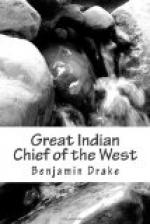On the 21st Sept. 1832, after the conclusion of the Black Hawk war, General Scott and Governor Reynolds concluded a treaty with the Sacs and Foxes, by which about six million acres of land were acquired, for which the United States were to pay them the sum of twenty thousand dollars per annum for thirty years, to pay off the debts of the tribes and to support, at the discretion of the President, a black and gun smith among them. A reservation was made of forty miles square, on the Ioway river in favor of Keokuk, (since purchased,) including his village, as a reward for his fidelity to the United Slates. Black Hawk, his son and the Prophet were to be held as hostages during the pleasure of the President. This is known as the “Black Hawk purchase.” The whole of the six millions lie upon the west side of the Mississippi and are included within the following boundaries: Beginning on the Mississippi river at the point where the Sac and Fox northern boundary line is established, by the second article of the treaty of Prairie des Chiens of 15th July, 1830, strikes said river; thence up said boundary line to a point fifty miles from the Mississippi, measured on said line to the nearest point on the Red Cedar of Iowa, forty miles from the Mississippi river; thence in a right line to a point in the northern boundary of the state of Missouri fifty miles measured on said boundary from the Mississippi river; thence by the last mentioned boundary to the Mississippi river, and by the western shore of said river to the place of beginning.
The Sac and Fox tribes are now residing on the west side of the Mississippi, and are living upon friendly terms with the United States. As a general remark, it may be said, that their intercourse with the United States has been of a pacific character. They took no part in the war of the Revolution: they were not parties to the Indian disturbances which terminated in the treaty of Greenville in 1795. Tecumseh and the Prophet failed to enlist them in their grand confederacy against the Americans, which was nearly broken up by the premature battle of Tippecanoe. The machinations of the British agents and traders, backed by the most liberal distribution of goods and fire arms, induced but a small party of them, not exceeding two hundred, to join the British standard in the late war with England. In the still more recent disturbance, on the frontiers of Illinois, called the “Black Hawk war,” but a portion of these tribes, took up arms against the United States, the great mass of them refusing to take any part in it; while Keokuk, their principal chief, exerted all his influence to dissuade the “British Band” from engaging in so hopeless a contest.
MA-KA-TAI-ME-SHE-KIA-KIAH,
OR
Black Hawk.
CHAPTER III.
Birth of Black Hawk—Early adventures—Battles with the Osages and Cherokees—Death of his father—Interview with Lieutenant Pike—Attack upon Fort Madison—Joins the British in the late war—Marches to lake Erie—Returns home after the attack upon Fort Stephenson—Murder of his adopted son—Battle of the Sink-hole near Cap au Gris—Treaty of peace at Portage des Sioux in 1816.




